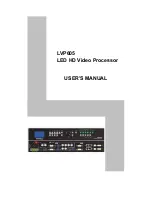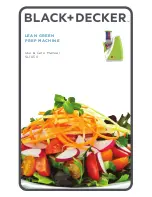
12
13
EN
The best size potato
for the peeling disc is
around 70mm x 70mm.
Choose potatoes that are
round, rather than elongated.
Peeling other produce
The peeler disc can peel potatoes very well
but it can also be used to peel other firm,
round produce such as beetroot.
It can also peel carrots and sweet potatoes.
Depending on the size, we recommend cutting
carrots and sweet potatoes in 2–3 pieces before
placing them into the bowl.
CHOPPING WITH THE QUAD
®
BLADE
The micro-serrated Quad blade chops raw and
cooked food to the consistency required, from
coarsely chopped to minced. The blades process
very efficiently, and may take less time than
expected to process many large tasks.
Raw vegetables, fruit and cooked meats
Trim and cut food into 2.5cm cubes.
Process no more than 7 cups at a time using
the PULSE button at 1–2 second intervals
until chopped to desired size or consistency.
Raw meat, chicken and fish
Trim excess fat and sinew, and cut food into
2.5cm cubes. Ensure all bones are removed.
Chill well in freezer until firm as this will help
to cut through the food more easily. Process
no more than 4 cups (600g) of raw meat at a time.
At this capacity the motor should run for no more
than 30 seconds at a time. Use a combination of
the START and the PULSE button until chopped
or minced to the desired consistency.
Leafy herbs
Wash and dry herbs thoroughly. Remove
any coarse stems. Process no more than
3 bunches of herbs (approx. 5½ cups) at a time
using the PULSE button at 1–2 second intervals
until chopped to the desired consistency.
Use leafy herbs immediately for the most
aromatic results in your recipe.
Nuts
Process no more than 5 cups of shelled
nuts at a time using the PULSE button
at 1–2 second intervals until chopped
to the desired consistency.
Nut butters
Process no more than 5 cups of shelled
roasted nuts at a time using the START button
until chopped to the desired consistency.
Soft breadcrumbs
Break stale bread into chunks (fresh bread
will stick to blades). Process no more than
6–8 slices at a time with the processing bowl,
using the PULSE button at 1–2 second intervals
until crumbed to desired consistency.
Dried breadcrumbs
Tear bread into chunks and toast in oven until
golden and crisp. Do not over brown. Process
no more than 6–8 slices at a time with the
processing bowl, using the PULSE button
at 1–2 second intervals.
Biscuit crumbs
Break biscuits into quarters, and weigh
a maximum of 500g (2 standard packets).
Process using the PULSE button at
1–2 second intervals until chopped to the
desired consistency. Sweet or savoury biscuit
crumbs can be used as an alternative to pastry
for sweet or savoury pies.
Do not process very hard biscuits (for example
gingernut biscuits) as this may damage
the blades.
Dried fruit
For dates and other larger dried fruits, remove
pits and cut into quarters before processing.
Process no more than 1 cup at a time.
Dried fruit can be sticky, and may stick
to the blades during processing.
We recommend putting dried fruit in the freezer
for about 10 minutes before processing.
Process no more than 2 cups (1 cup for
large fruits) at a time using the PULSE button
at 1–2 second intervals until chopped to the
desired consistency.
OPERATION
Getting started
The food processor will only operate when
the processing bowl, lid and large pusher are
correctly assembled. This engages the safety
interlock, and allows the motor to run.
The chute has a CHUTE FILL MAX graphic
to indicate the maximum volume of food that
can be placed in the chute for the pusher to
activate the safety locking catch.
Control buttons
The momentary PULSE button is ideal for
processing foods that need sudden bursts
of power. It also encourages ingredients
to move around the bowl. PULSE is also
best when processing foods that only
require processing for a short period of time.
After Processing
After processing, wait until the blades/discs
have stopped moving before unlocking the
lid. To ensure safe handling, turn off at the
POWER button and unplug at the power
outlet before handling the blades.
When removing blades/discs, lift the part
by carefully gripping the plastic hub in
the centre.
DICING WITH THE DICING KIT
The dicing kit dices raw and cooked food
into cubes of the size of 12 x 12mm.
Always remember to place the geared
spindle, dicing grid and dicing disc into
the food processor before adding the food.
Do not dice more than 10 cups (2.4l) in your
food processor at a time. Exceeding this
capacity could lead to the product jamming
in the disc. It will also make the cleaning
process of the dicing grid challenging.
Clean dicing grid each time after dicing
10 cups.
Vegetables and fruits
The dicing kit can process raw and cooked
vegetables and also fruits. To improve dicing
results for harder vegetables like carrots and
pumpkin, par-cooking is recommended. Only
par-cook vegetables that need to be cooked
afterwards.
For best results when dicing with raw, hard
vegetables feed carrots length-ways through
the small feed chute, and feed pumpkin through
the medium feed chute. Feeding this produce
through the large feed chute may lead to
jamming of the disc.
DO NOT DICE SWEET POTATO
(Yam/Kumara).
Due to its dry, fibrous texture dicing sweet
potato is not recommended with the
Dicing Kit. Sweet Potato places high load
on the Dicing Kit which causes high friction
and potential damage to the Bowl Lid.
Use the START / PAUSE button for control
when dicing food.
PEELING WITH THE PEELER
Potato peeling made easy
Take the hard work out of peeling potatoes.
The Sage peeler will peel potatoes in batches
of 6–7, depending on the size. Peeling is very
fast, and may finish quicker than expected.
Keep your eye on progress, and it should be
done in 25–30 seconds.
Size matters
The best size potatoes to use are around
70mm x 70mm, which is about the size
of this illustration. Choose potatoes that
are round, rather than elongated.
Use whole potatoes, as cutting potatoes
into half or quarters creates square edges
that won’t peel efficiently. Using rounder
potatoes will reduce the amount of waste.
Loading the potatoes
Position 6–7 potatoes evenly on top of the
peeler. Potatoes should have enough room
to freely roll and rumble. If potatoes are too
tightly packed, the peeling won’t be as effective.
Keep in mind that the peeling works best with
a complete batch, and peeling just a couple
of potatoes won’t be as efficient. Lock lid
in place before starting, and never insert
potatoes through the chute.
Functions








































